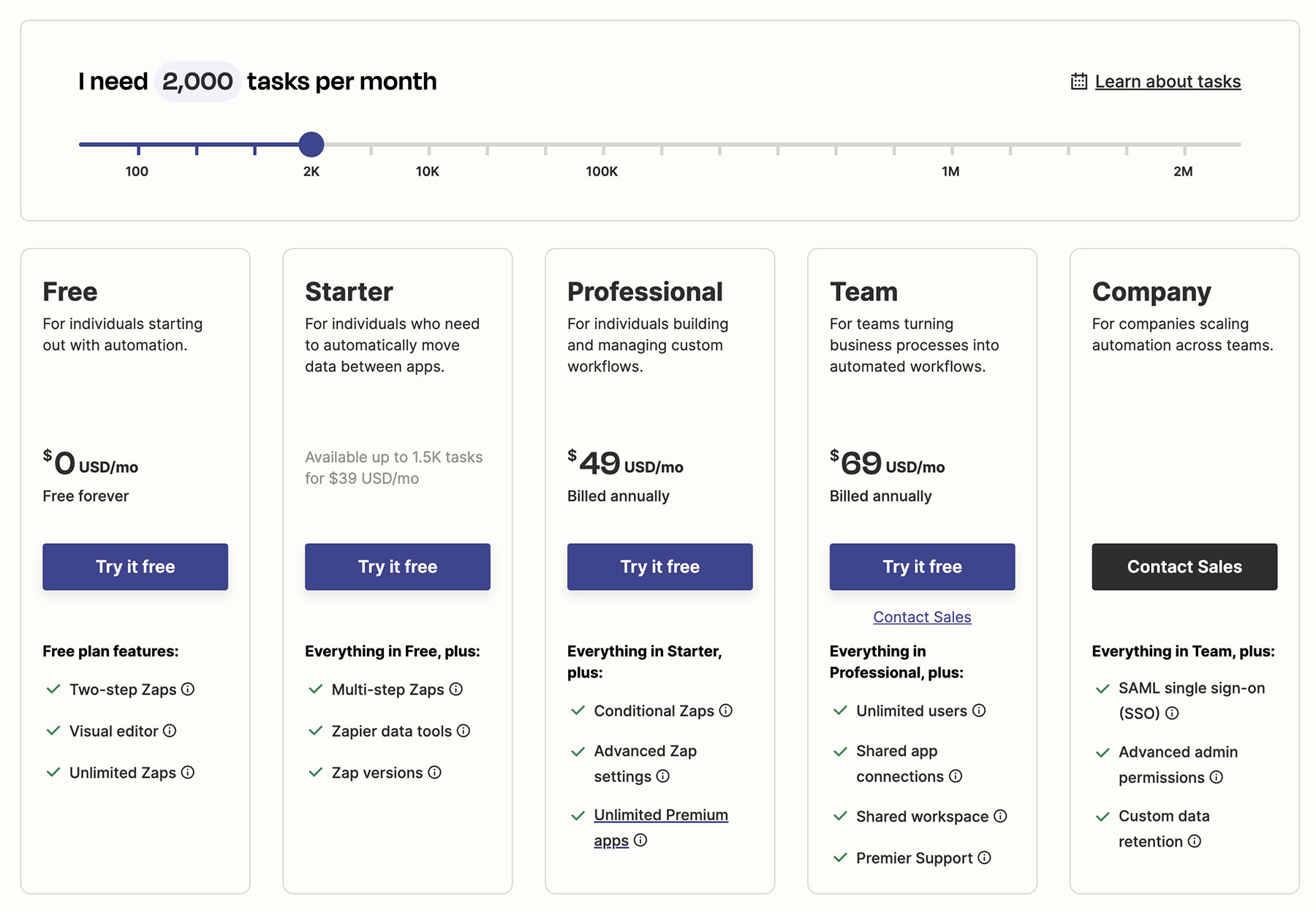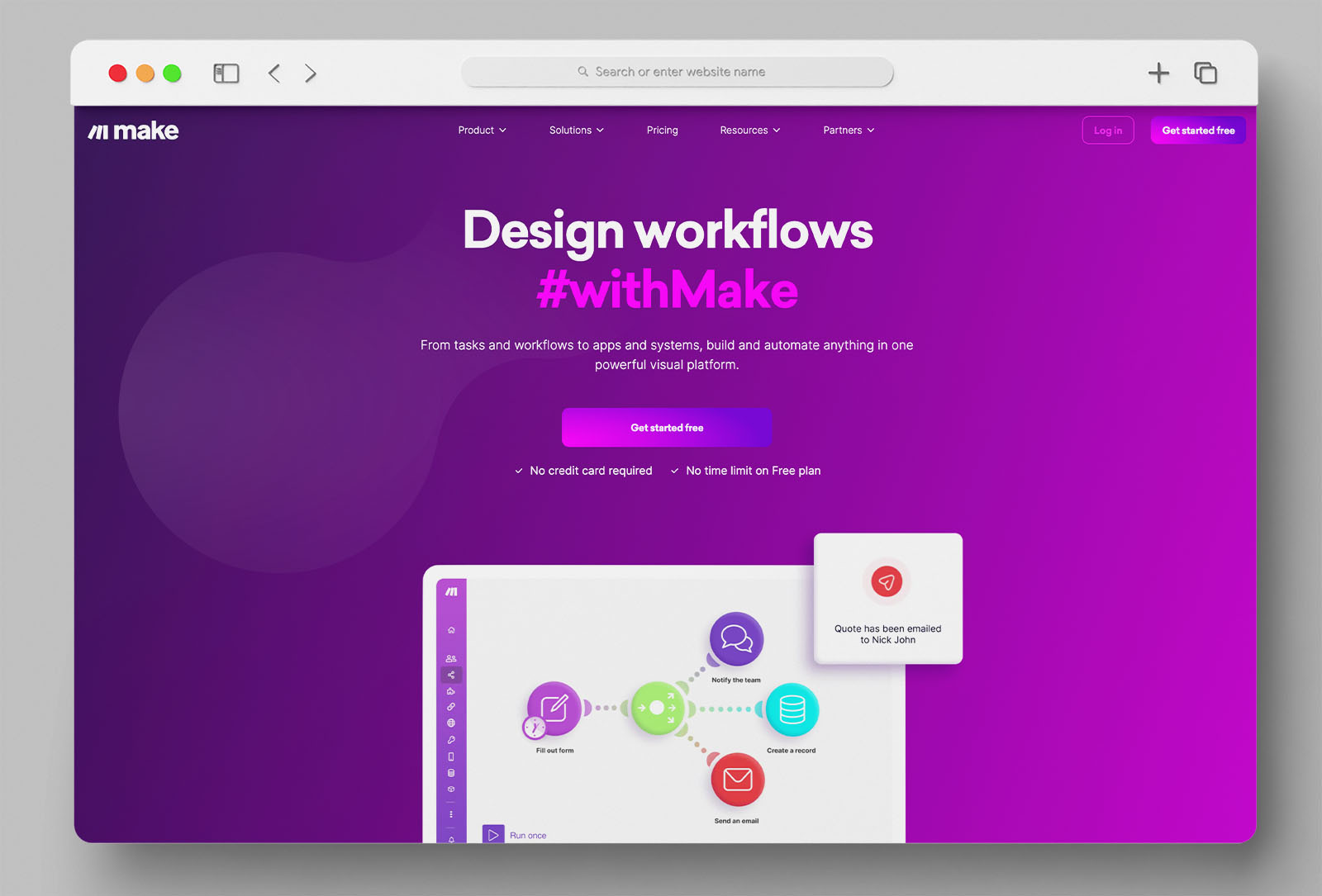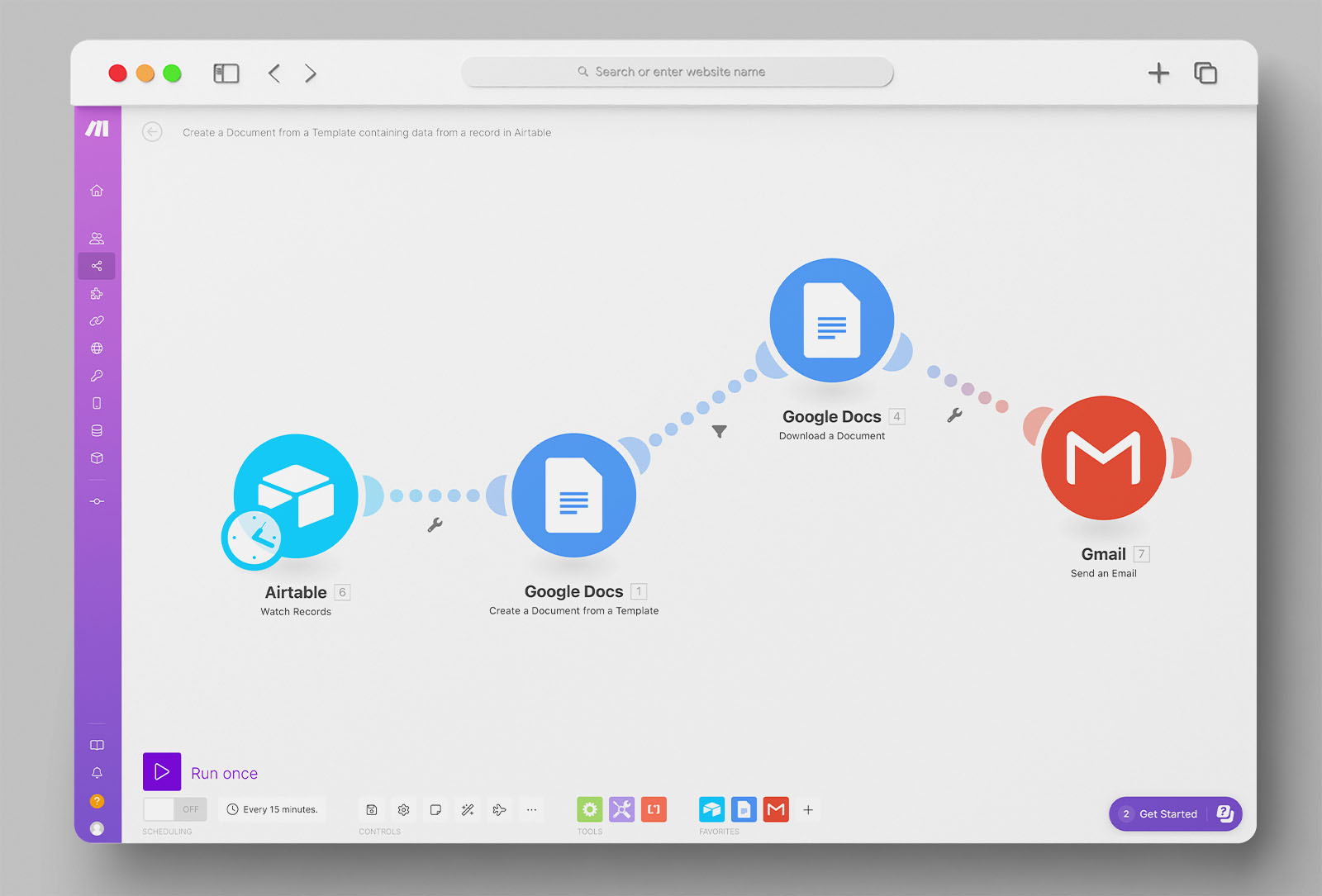
Make vs Zapier
Helping you pick the right automation workflow software for your needs.
Quick Summary:
So you're looking into Make vs Zapier and wondering which is best for your needs, well put simply, both do a great job at automation but consider the below key factors:
- Make is often substantially better priced for many people
- Zapier's user interface is easier to use however Make gives you more powerful workflows
- Zapier has more integrations however Make has the majority than most people need
- We personally moved to Make.com after our Zapier plan needed upgrading to $49/month, Make costs us $9 for the same with far more capacity too
- You can get 12 months free on Make's Team plan via FounderPass here
Don't forget each have a free plan, check out the Make free plan and the Zapier free plan and try them out to see which is right for you.
Updated:
May 14, 2024

By Max
When it comes to automation tools there’s no denying that Zapier are the most widely known option but in 2024 companies like Make are quickly becoming the preferred option for many. This guide takes a look at Make vs Zapier and helps you make a decision on which to use from our own experience and from an honest perspective. We've personally used both Zapier and Make, having paid for both and experienced both the pros and cons of each so we can pass this on to you.
Zapier vs Make - Which is the best
Firstly, no matter which of these you pick you’ll get a good solution, however there are a number of factors you need to take into consideration when choosing.
Price - Make is the winner by some way with substantially cheaper pricing
Make is cheaper than Zapier and by some way (we personally dropped our spend from $49/month on Zapier to $9/month on Make whilst increasing the number of flows/zaps we could do).
We’d recommend taking a look at the Zapier pricing and the Make pricing pages and comparing the number of tasks/operations you do and seeing how the pricing compares.
Integrations - Zapier wins but Make still suits most peoples needs
With over 5,000+ integrations Zapier has the most apps available for you to work with, don’t rule out Make though as it has over 1,200+ and in most cases unless you’re using very niche apps you’ll find what you need. Check out the list of Make integrations to check if it has the apps you use.
Note that Zapier does put call some apps ‘premium apps’ and these are only available on Professional plans, so bear this in mind.
Ease of use - Zapier wins if you’re newer to automation, Make wins if you’re more visual and want more possibilities
One thing we saw moving from Zapier to Make was that where Zapier has a list type user interface where you simply select from dropdowns what you want to do, Make has a diagram/mind map approach, which takes a little getting used to but then gives you some powerful options.
How to pick the right automation software
Automating workflows can save you countless hours, make your business more efficient, more profitable and give a better experience to users, but working out which tool to use for these automations is key.
When we started automating workflows we instinctively used Zapier, we’ll be honest, we knew they would be alternatives but weren’t sure who they were or if they were any good.
Zapier worked great for us, however a year in we hit the limit on the plan we were on, the next plan up seemed quite expensive for what we were doing so we started looking Zapier alternatives. This is when we discovered Make.com and quickly realized not only was it more powerful but for us it worked out a lot cheaper (it cut out monthly bill by around half yet gave us more than double the capacity).
Make vs Zapier Pricing
Pricing should always make up a feature when it comes to deciding on signing up to a company, even when it may seem a low cost to begin with, if you scale and start using thousands or tens of thousands of automated operations a month the cost can quickly rise.
Zapier charges you a monthly fee based on the number of tasks you use, each plan will have for example up to 1,000 tasks a month limit, if you go over this you’ll need to upgrade the plan at a cost.
A task is a completed automated workflow, it can have multiple steps and everytime it runs and completes successfully that counts as 1 task.
Make also charges monthly but they charge based on the number of operations, like Zapier you’ll get a set amount per month i.e 10,000 ops/month, if you go over this you’ll need to upgrade the plan.
Important to note that an Operation on Make counts as each step of a workflow, so if you have say 5 steps in a workflow, every time that completes it will count as 5 operations not 1 like it would in Zapier.
Below you'll see the current 2024 pricing for Zapier and Make, we've selected 2,000 tasks per month for Zapier and 10,000 ops per month for Make, this shows a similar pricing if each task has roughly 5 steps.
As you'll see it's still signifcantly cheaper to use Make, and if most of your workflows are just a few steps then the price can be even cheaper.


In general for any scenario we’ve put in apart from those which have a large number of steps in each workflow, Make comes out cheaper for us. We’d recommend working out a rough average number of steps you’d have in your workflows, say 5 is the average, a 10,000 ops/month plan on Make.com would then give you roughly 2,000 completed tasks.
Automating workflows in general
We won’t go into too much detail here as we’ll assume you know the benefits of automating workflows as you’re already comparing Make vs Zapier, you may even be an existing Make or Zapier customer already, if so you can skip this section.
The core benefits of automating workflows is of course the time saving, rather than manually having to do task, you can set up a trigger that then performs an action. Examples include when a user signs up on your website, it triggers a workflow where by it adds this user to a certain list in your email provider, whilst also listing it in your CRM for you or your sales team to reach out to them.
Zapier vs Make Free Plans

So you don’t want to spend any money, fair enough, if you’re only doing a limited number of automations then it’s great to use a free plan.
The good news is that both Zapier and Make both have free plans available for you to use.
Zapier tend to have the better free plan, as they have unlimited ‘Zaps’ but you’ll be limited to ‘Two step Zaps’ this means that you can set up a trigger that then does another task but you can’t then do other tasks. Make on the other hand has a limit of 1,000 ops/month but you can have multiple steps.
INSERT IMAGES
Therefore if you’ve got very basic automations i.e Someone does X and then that triggers Y to happen then Zapier will be your best bet, if you have a small number of automations that are more complicated and have multiple steps then Make will be a better option.
Make vs Zapier apps
If you just look at the pure number of apps available then Zapier clear wins with some 5,000+ compared to Make’s 1,200+ however you shouldn’t look at this as a numbers competition.
The key here is that the tool you opt for has the apps you use, it’s no good opting for Zapier cause it has 3,000 but then doesn’t have one of the apps you use, therefore check both sites list of apps to see if they have the ones you use.
You will find that the core apps that 98% of people will need are available on both companies platform, meaning this factor may not one you put into consideration when making a choice between Zapier or Make.
How Zapier works?

If you’re thinking of switching or using Zapier then you’ll want to know how it works, we’ll give you a basic guide to how it works but for your best experience you’ll want to create a free account and have a play yourself.
Zapier allows you to create automations, which they aptly name ‘Zaps’ and the basic of these can be split into two different forms:
- A Trigger - this is an event that happens that triggers the Zap to start i.e this could be when you make a sale on shopify or when someone signs up to a newsletter
- An Action - this is the action that then performs after the above trigger has been triggered i.e when the sale on shopify trigger happens you updated a sheet with the sale price or when a user has signed up to a newsletter their email and name goes into your CRM software
You can either set these up manually yourself or you can use existing templates that they supply, either way its straightforward and easy to use.
You can further advance these Zaps by using logic and conditions, for example you could say only update your spreadsheet with the Shopify sale if it’s a new customer.
You can set up Zaps which have multiple different actions based on conditions/logic as well as numerous different steps across numerous different apps.
How Make works

The more visual of the two, using Make is similar in essence to Zapier but you build everything on a drag and drop based workspace.
You can simply add new elements, triggers, set up conditional elements, then link them up to actions.
For Make we would recommend either having a play around yourself or watching some tutorials first, so you can understand how it works as it slightly more complicated and advanced than Zapier.
Comparing User interfaces
Choosing between Zapier and Make may come down to how you find using each of their platforms, there are relatively different albeit both ultimately doing the same thing.

Zapier has a no-code easy to use interface where you simply select from dropdowns the actions you need, the triggers and so on and Zapier will prompt you with all the help you’ll need to set these up.
This makes setting up the automations a breeze and one you’ll be able to do quickly.
Make on the other hand also has easy selection of triggers, steps and automations however it’s set out more of a workflow diagram that you’ll recognize more of a mind map. This at first may look a little daunting but after using it you’ll quickly realise it makes sense to set them out like this.

This approach for us personally made setting up the bigger and more complicated workflows easier and also with this setup you can create some seriously impressive and powerful workflows.
Zapier therefore is best for those wanting basic automation and who prefer more of a guided approach, Make is much better for businesses looking to create powerful automations and are happy to devote more time to create them in order to save time in the long run.
How they cope with broken automation
When setting up automations, you’ll no doubt create some that don’t work, they’ll be a step or part of a step that doesn’t work. This is frustrating but expected when you start, but when it comes to fixing those Make do a much better job.
Make give you more hints as to where the issue is, gives error logs and more meaning it can be quicker to work out where the issue is and how to fix it.
Automated Workflow Templates
When it comes to Make vs Zapier as to which is better for offering prebuilt templates for your automation Zapier just wins this, they have a wider available library and allow you to see these options when you’re creating the workflows.
Make do also offer a wide number but these must be viewed on another page, not really a big issue but we do prefer how Zapier do it.
Make vs Zapier - So which to go for
If you were to ask us based on our own experience we would opt for Make over Zapier, mainly down to price, user interface and the power of Make.
Does this mean that Make is better than Zapier, certainly not, it will come down to which is best for you and your needs.
Therefore we recommend that you read this guide as exactly what it is, a guide, and then make an informed decision based on the factors we’ve mentioned.
One hands one ay you can make a decision is to try a free trial of each, have a play around with them, set up some automations that fit within the free plan and test it. It’s likely from this you’ll then make a decision.
If you’re already a Zapier or Make customer and are looking for an alternative then hopefully this guide will have helped you work out if the other option is a suitable alternative.
Information we provide is for general information and does not constitute financial advice. Always ensure do your own research when making decisions especially financial ones.
We may earn a small commission from some companies that we are affiliated with, this does not affect our reviews or information provided, this simply helps us run FounderPass and help give you the best information possible.
.png)





